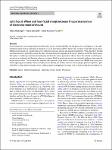Item Infomation
Full metadata record
| DC Field | Value | Language |
|---|---|---|
| dc.contributor.author | Tobias, Maiberger | - |
| dc.contributor.author | David, Schindler | - |
| dc.contributor.author | Nicole, Koschate-Fischer | - |
| dc.date.accessioned | 2023-05-04T04:26:40Z | - |
| dc.date.available | 2023-05-04T04:26:40Z | - |
| dc.date.issued | 2023 | - |
| dc.identifier.uri | https://link.springer.com/article/10.1007/s11747-023-00932-8 | - |
| dc.identifier.uri | https://dlib.phenikaa-uni.edu.vn/handle/PNK/8391 | - |
| dc.description | CC BY | vi |
| dc.description.abstract | Facial emojis have increasingly permeated electronic word of mouth (eWOM), but the persuasive consequences of this phenomenon remain unclear. Drawing on emotions as social information (EASI) theory, this research reveals that facial emojis influence persuasion (e.g., product choice) by affecting emotional arousal and perceived ambiguity. While the effect through emotional arousal is generally positive, the effect through ambiguity depends on the emojis’ function in eWOM: facial emojis that replace a verbal expression increase ambiguity and therefore reduce persuasion, whereas those that reiterate a verbal expression decrease ambiguity and therefore enhance persuasion. Both the emotional-arousal and ambiguity pathways determine the net persuasive effect. This research also explores two situations (high verbal context richness and eWOM from strong ties) where replacing facial emojis can increase persuasion. | vi |
| dc.language.iso | en | vi |
| dc.publisher | Springer | vi |
| dc.subject | eWOM | vi |
| dc.subject | EASI | vi |
| dc.title | Let’s face it: When and how facial emojis increase the persuasiveness of electronic word of mouth | vi |
| dc.type | Book | vi |
| Appears in Collections | ||
| OER - Kinh tế và Quản lý | ||
Files in This Item:

